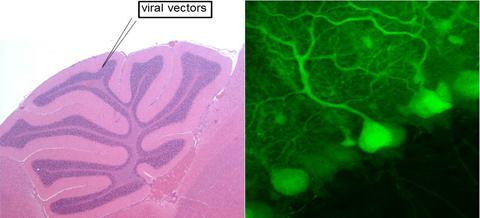The Cerebellum: Mediating Cognition and Behavior?

The cerebellum has well documented roles in the regulation and coordination of motor learning and behavior. The cerebellum, however, has recently been implicated in the regulation of nonmotor functions.
Tracing studies demonstrate connections with nonmotor areas of the cortex, while resting state MRI demonstrate functional connectivity of large parcels of the cerebellum with cortical areas that are unrelated to motor functions.
Furthermore, clinical lesions of the cerebellum result in high rates of cognitive and behavioral dysfunction while cerebellar abnormalities are the most consistent pathologic finding in patients with autism spectrum disorders (ASD).
Autism and mTOR Dysregulation in the Cerebellum

Rodent models help investigate the mechanisms underlying autism spectrum disorders.
To evaluate the role of cerebellum in ASD, we asked first whether cerebellar dysfunction is sufficient to generate abnormal behaviors. We generated a mouse whereby one of the genes deleted in Tuberous Sclerosis Complex (TSC), a neurodevelopmental disorder with high rates of ASD, was lost in cerebellar Purkinje cells. Loss of this protein results in dysregulated increases in mTOR signaling and resulting alterations in protein translation. These mutant mice demonstrate autistic behaviors, pathology consistent with clinical ASD, and electrophysiologic dysfunction consistent with studies in the disorder.
Presently, we are investigating the molecular underpinnings to better unravel the underlying etiologies of these phenotypes.
Shown: Rodent models help investigate the mechanisms underlying autism spectrum disorders.
Cerebellar Circuits and Behavior
The lab is also investigating the mechanisms by which cerebellar dysfunction contributes to cognitive and behavioral abnormalities. To answer these fundamental questions, we are utilizing a diverse array of approaches spanning rodent behavior, molecular and cellular biology, microscopy, electrophysiology, and genetic models in combination with viral and nonvirally delivered tools to specifically manipulate neuronal function and better ascertain the contribution of cerebellar dysfunction to disease.
Translation
In addition to our goal of improving our basic mechanistic understanding of how the cerebellum regulates cognition and behavior, we are also performing studies that can inform and identify therapeutic avenues.
We are investigating basic questions around treatment windows and critical periods while also working to identify molecular targets that will inform development of future therapeutics.
Summary
The central nervous system is a complex diversity of communicating neuronal circuits that exist within large distributed circuits in combination with local hub networks. This diversity of neuronal inputs and outputs contributes to an elegant expression of thought and behavior that is misexpressed or dysfunctional in neurologic disease or neurodevelopmental disorders. Understanding the complex interplay between molecules, the varied cellular substrate within the central nervous system, and these diverse neuronal circuits is critical to our understanding of behavior and even more critical for the understanding and treatment of neuropsychiatric disorders such as behavioral dysregulation, learning disabilities, cognitive dysfunction, and autism.